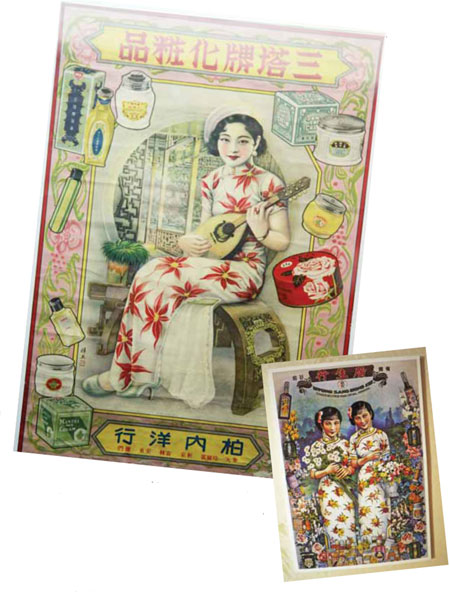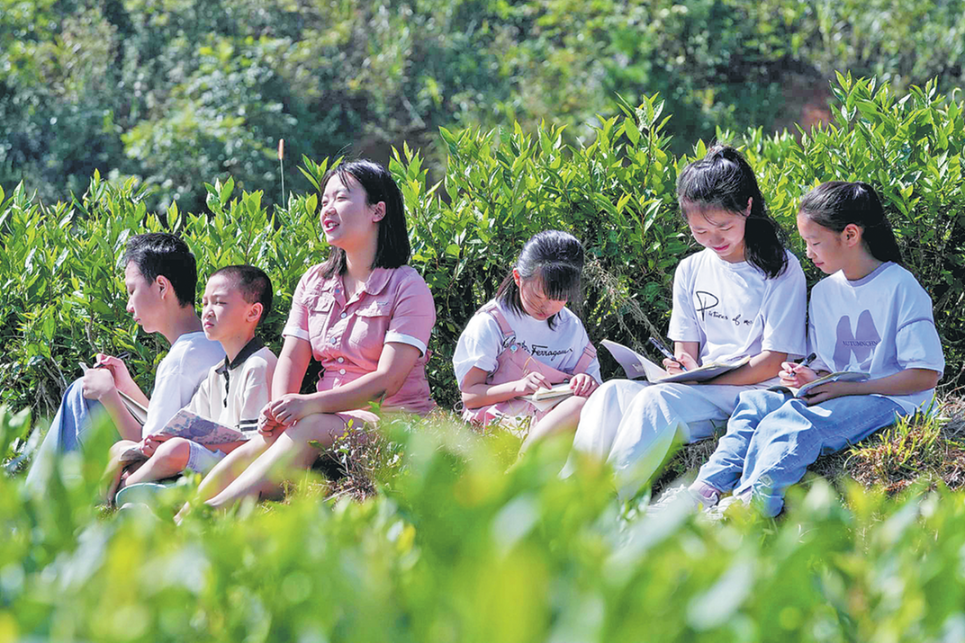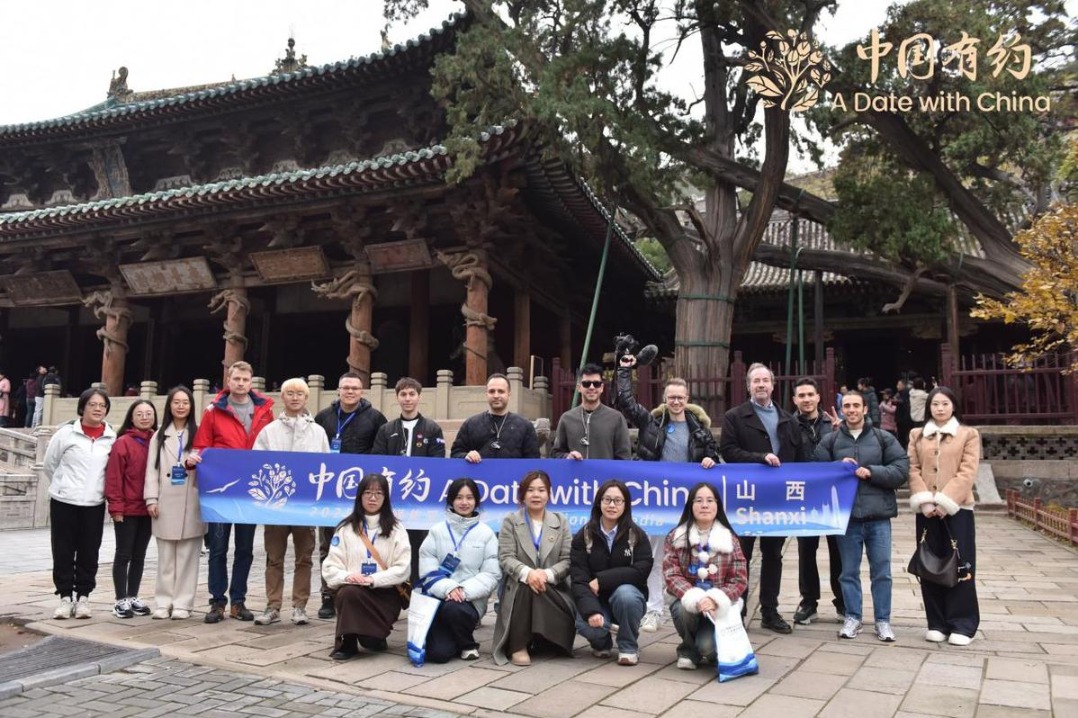Beauties beckon

| Left: China's earliest makeup companies used yuefenpai for commercial and advertising purposes. Below: Kwong Sang Hong, one of the first cosmetic companies in China, featured two girls on their signboards and products in the 19th century. Provided to China Daily |
Classic Chinese pin-up girls continue to allure with their distinctive style
Long-legged, high-heeled and usually posing in swimwear or lingerie, the pin-up girl flourished in the West during the 1930s and 40s. Photos and illustrations of these cheery glamour models appeared on calendars, postcards, posters and in magazines, and were pinned up to attract, and distract, one's attention.
But pin-up girls had blossomed in China many years earlier. Called yuefenpai, these were the calendar girls of the late 19th century, during the reign of Emperor Guangxu of the Qing Dynasty (1644-1911).
Paintings of the Chinese beauties adorned the months of the calendar, and accompanied details about the climate and other natural phenomena of the relevant season. These images were mostly based on historical or legendary characters, and many people of the time pinned them up on the walls of their homes.
"These pictures are valuable now, because they were the earliest Chinese posters. The calendar girls vividly portrayed in them were glorified," says Zhou Li, a head of a postcard printing manufacturer in Beijing.
It was not long before yuefenpai started to be used for commercial advertising and promotion. Kwong Sang Hong, founded in 1898 and one of the first cosmetic companies in China, featured two girls on its signboards and products. These beauties were the pioneers for the glossy makeup advertisements. They wore the traditional qipao, green embroidered with orange flowers, and looked sweet and natural.
More than a century later, Kwong Sang Hong still uses the "Two Girls" brand and logo on their promotion material, with a twist of the modern.
"Yuefenpai poster art was more common in Shanghai during the 1920s and 40s. These images were influenced by Western elements and successfully used in advertising, giving recognition to the artists," Zhou says.
Since Shanghai opened as a trading port in the mid-19th century, advertisements for Western products in China were mostly based on European classical portrait or landscape painting, so the yuefenpai image was a refreshing, if not daring, move.
"The calendar girls represented the changing image of modern women at that time. They had traditional Chinese features to distinguish them but also blended well into the Western style," Zhou says.
"Master Zheng Mantuo, a prestigious artist of the time, created a yuefenpai beauty who wore a white silk shawl and a European watch on her wrist, which hinted at her worldly sophistication during that period."
Yuefenpai paintings usually featured popular singers and movie stars or legendary beauties from Chinese literary classics. Old Shanghai's calendar girls graced the covers of many novels and spiced up the development of the film industry, paving the way for modern Chinese culture.
"Nowadays, lots of people are interested in collecting reproductions of postcards and other products that feature calendar girl prints," says Meng Jiahao, a vendor at Beijing's Panjiayuan antique market.
"Even some foreign visitors look for yuefenpai prints to hang on the wall. Many say the belles in the picture match their impressions of Chinese classical beauty."
However, this later generation of yuefenpai girls are usually depicted with curly hair or long, waving locks, a la mode. Most wore a tight qipao, slit at the sides from the thigh, that hugs the curves of the body. Chubby cheeks, powdered to give a rosy blush, arch eyebrows, red lipstick, an ample bosom, slender waist and full hips were all de rigueur. A roguish grin or chipper smile, accompanied by a glint of je ne sais quoi in the eyes, or just a wink, were all suggestive of more than just a change in how society saw pretty women in the 1930s.
Compared with these "vamps", the earlier yuefenpai girls were demure and bashful in their elegance. They reflected the inherent quality of traditional Chinese morals and public reserve.
A slender, young woman, who appeared gentle and looked in need of care and protection, was previously considered the essence of Chinese beauty. But by the time the 1930s arrived, this image was regarded as too bland.
"The characterization of modern women in yuefenpai paintings was not only limited to the female shape. There were many other themes in the artwork closely related to the joys of daily life, such as traveling, sports, shopping, child-rearing and social networking," says Zhang Huoyan, a professor at the Academy of Art and Design at Tsinghua University.
A mother doting on her bonny baby was another popular setting for yuefenpai paintings. But, in complete contrast, girls were also imaginatively portrayed as aviators, motorcyclists and athletes, though there was no such thing in real life. These images pandered to the Chinese people's ideal of the modern woman during that period. They were supposed to be strong, open-minded, independent and brave.
Zhang describes the painting technique employed as one of Chinese watercolor combined with Western brush rubbing sketch by charcoal.
"To make this commercial art more appealing, this method enhanced the smooth skin of the girl and the texture of her clothes and accessories she is wearing," Zhang says.
If you are looking for the best examples of yuefenpai painting, Zhang regards Zheng Mantuo, Zhou Baisheng, Xu Yongqing and Hang Zhiying as masters of the craft.
Their pin-ups may seem like a far cry from those of Alberto Varga or any featuring Betty Grable - but just as alluring.
"Yuefenpai may be influenced by the West, but Chinese artists have turned it into a distinctive art style," Zhang says.
yinyin@chinadaily.com.cn
Today's Top News
- Japan unqualified for UN Security Council: Chinese envoy
- Deforestation is climate action's blind spot
- Japan unqualified for UN Security Council: Chinese envoy
- China, Germany reach outcomes after discussions
- Chinese cities dominate global science hub rankings
- Japan's tourism battered as Chinese travelers cancel trips
































